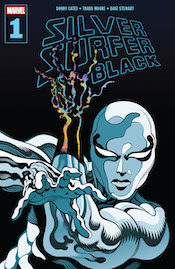Thursday Comics Hangover: Hi-ho, Silver

I didn't enjoy the Silver Surfer as a kid, because as a kid I was interested in the plot of superhero comics — I was most interested in learning if good would triumph over evil (spoiler alert: it would). But the older I get, the more fondness I find in my heart for the Silver Surfer. He's a silver Oscar statuette on a surfboard, soaring through outer space and musing aloud in huge, unselfconscious monologues about ideas like guilt and loneliness and destiny and forgiveness.
Every Silver Surfer comic is a journey into interiority. The bad guys and their motivations don't really matter. What matters most is if the Surfer can come to some kind of a comfortable understanding with his own place in the universe, even if that understanding lasts just until the next issue.
Yesterday saw the release of the first issue of Silver Surfer Black, a miniseries written by Donny Cates, drawn by Tradd Moore, and colored by Dave Stewart. It ties in to a whole bunch of current Marvel Comics, but narration catches up new readers with relative grace in the first few pages.
The first thing any great Silver Surfer comic needs is a brilliant artist, and Moore is one of the best to handle the character since Moebius. Every page is stunning — gorgeously designed, sumptuously illustrated, and delightfully weird. It's rare to find a comic artist who appears to be raised in a vacuum — whose work doesn't feel like a retread or a generational step up from some other comic artist.
Moore's pages feel unique. In a few layouts, the action flows smoothly in what most comics artists are trained to believe is the "wrong" direction, and it's as easy to follow for western readers as a Peanuts strip. One page just looks like Surfer floating above a weird cosmic blanket, and Moore makes it twice as compelling as any superhero fight you'll find in a new comic this week.
I have no doubt that Moore's art in black and white is beautiful on its own, but Stewart's coloring elevates the book. By contrasting the darkness of a black hole with the colors of the interstellar firmament, and by plunging the Surfer into a hostile pit of browns and oranges, Stewart divides the book into a few distinct sections that reflect the character's interior life.
And Cates seems to understand the character's need for internal monologues. The Surfer spends an early part of the book luxuriating in self-pity over his complicity in the death and destruction of his past. He comes face to face with an existential loneliness that leaves him shaken, and then, well, there's a concluding bit that reveals a villain and it ties back into something else that Marvel is doing right now and things appear to be getting a little crossover-y.
The Silver Surfer is a character who almost always excels when he's left on his own. When he's thrown into a battle scene with dozens of other heroes he immediately becomes a generic powerful guy, albeit one who speaks in ten-dollar words. The challenge for Cates in the next few issues of Black is to tie the Surfer into Marvel's current happenings — gotta sell those books somehow — while still saving what's unique about the character. But even if Cates can't manage that tightrope walk, though, Moore's art will be stunning enough to make Silver Surfer Black a must-read.